CarPlay
Overview
Driving a vehicle and using your phone or tablet at the same time is usually forbidden by law for safety reasons. CarPlay is software that provides an adapted and optimized version of the OsmAnd app for safe use while driving, making it easier and more secure to access the app's navigation functions.
To use CarPlay on your vehicle screen, follow these steps:
- CarPlay is not available in all countries. Make sure it is supported in your country or region and that CarPlay is supported in your vehicle model.
- Connect your device to your vehicle multimedia system using a USB port or wirelessly with Wi-Fi or Bluetooth. When connecting for the first time, you may need permission to use CarPlay on your device.
- Once connected, the CarPlay interface will automatically appear on your vehicle screen with all available apps. If the CarPlay home screen does not appear, select the CarPlay logo on the vehicle display.
CarPlay Interface
CarPlay is not a direct replication of the OsmAnd mobile app. It has a simplified interface, focusing on essential navigation functions to ensure safe driving. Some advanced features are not supported due to platform limitations.
Connection Screen
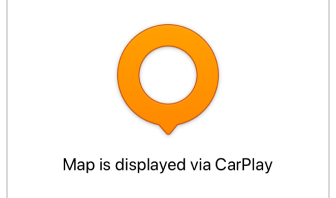
While your device is connected to CarPlay, the map on the app screen is locked. This is an intentional security feature to ensure that navigation is controlled exclusively from the car display, minimizing distractions while driving. Check the common questions about the connection screen.
Location Position in CarPlay
The OsmAnd app for CarPlay allows you to adjust the position of the current location indicator on the screen to avoid overlapping the route and other important map details.
How to change the indicator position:
- Go to Menu → Configure screen → Other → Location position on screen.
- Select your preferred placement:
- Automatic (default). The application automatically shifts the position of the indicator for navigation mode or free movement.
- Center. The indicator is placed in the center of the screen, suitable for standard navigation.
- Bottom. The indicator is positioned closer to the bottom of the screen, making it easier to observe surrounding objects and complex intersections.
Interaction with the Map
-466b0c9abefb147fbf9e87a01301e7ec.png)
CarPlay displays the OsmAnd interface adapted to the vehicle multimedia system screen. Interaction with the map is limited to:
- My Location. Moves the visible part of the map so that your current location is in the center of the screen.
- Zoom. Allows you to zoom in and out of the visible part of the map.
Required Setup Parameters
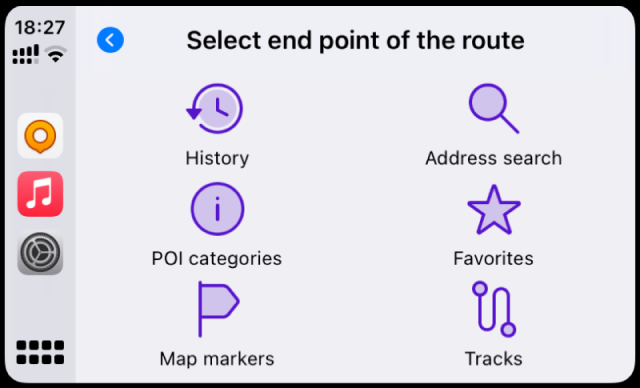
- First, you need to select and configure the profile to be used when connecting to CarPlay. You can read how to configure a profile in the article Profiles (Settings).
- A convenient profile for using CarPlay can be Driving, and the type of routing can be Car routing.
- OsmAnd has a separate item CarPlay Profile for quick access to the list of profiles available for connecting to CarPlay.
- For OsmAnd to work, connect your iOS device to the vehicle multimedia system. To find out more about how to connect and set up your device, you can visit the CarPlay website.
- You need to have one of OsmAnd paid or subscription. Check it here Menu → Settings → Purchases.
- Once connected, you can set a destination and start OsmAnd navigation in CarPlay.
You may need an Internet connection to use OsmAnd in CarPlay. If your device has limited Internet access, you can preload or create routes and use them without the Internet.
Start Navigation
-6acc3780f5b265ac475a5a7eacbc5d3d.png)
To use the iOS version of the OsmAnd app in CarPlay, you have to purchase a paid version of the app or to subscribe.
- To create a route, you need to choose the route endpoint on the CarPlay screen or in the OsmAnd app.
- You can use voice prompts to listen for directions or messages about issues on the road.
- After you select a location, press Start to follow the route.
- As you drive, the vehicle screen will display OsmAnd information about your current location on the map, driving directions, distance to the next turn, lines, arrival time and distance to your destination.
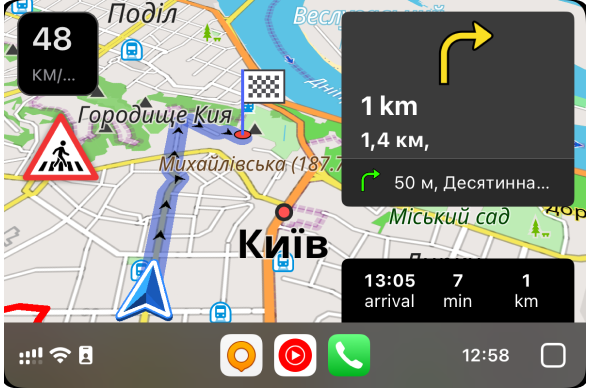
- If you want to change your route or select a different location, you can press the appropriate button on the screen.
- Once you have completed your route, you can deactivate CarPlay by disconnecting the device from your vehicle multimedia system.
All categories for route endpoint selection, History, POIs, Markers, Search, Favorites, and Tracks may contain no more list items than your vehicle multimedia system provides. Typically, in most vehicles, lists are dynamically limited to 12 or 24 items. This means that the list in CarPlay may not be complete. The total number of items and the actual number of items displayed is indicated under the folder name.
CarPlay Profile
Menu → Settings → CarPlay profile
CarPlay profile is a specific profile in the OsmAnd app for convenient use of your car's audio and video system for further display of this data on your phone.
This profile is used as long as your device is connected to CarPlay. Tap the CarPlay profile field in the OsmAnd settings menu and from the list of profiles enabled for use select the profile with which CarPlay will be activated.
You cannot select a profile directly in CarPlay from the vehicle screen. First, select the required profile on your device and attach the CarPlay profile to it. You should select a profile that corresponds to the type of vehicle, such as Driving, Truck, Car, Motorcycle, or Moped. The app will automatically activate the CarPlay profile when connected to a vehicle.
Why it is important to select the appropriate profile for your type of vehicle.
- Driving safety. Different types of transportation require different information and settings when driving. For example, truck drivers may be limited in the height, weight, and width of their vehicles, so the Truck profile provides them with appropriate restrictions and guidelines. While bicyclists and motorcyclists need information about bike lanes and routes, without data for trucks.
- Utility and Efficiency. Navigation should be customized to meet the needs of a particular mode of transportation. This allows users to reduce the time it takes to find optimal routes and avoid unnecessary traffic restrictions.
Select a Route Endpoint
You can select previously preset and added POIs, or Favorites, or Markers as a destination point. It is also possible to select a recorded or downloaded Track for the route, use the Search, or select a destination from the route History.
If you want a particular location on the map as an endpoint, select the appropriate category of points from the list, POIs, Favorites, or Map Markers.
- All categories can contain no more list items than are provided by your vehicle multimedia system. This means that the list in CarPlay could be incomplete, and all other folders are only available in the OsmAnd app on your device.
- The Last modified folder contains a list of recent destinations, sorted by date added or changed.
- The list of all other folders is sorted by the most recent update, new folders are at the top of the list. It is not possible to change their order manually.
- The list of points within folders is sorted by the distance to them, starting with the nearest. Each point has a name or coordinates, a shaped icon (color and icon set by default or chosen by you in the OsmAnd application), and the distance from the point of the current location to it.
Select the History category to find one of the recent destinations that are stored in the device's memory.
Select Search to enter a destination from the available search categories.
While driving, selected points can be announced when you approach or pass them. See the Voice prompts settings in the appropriate article to set up voice notifications.
History
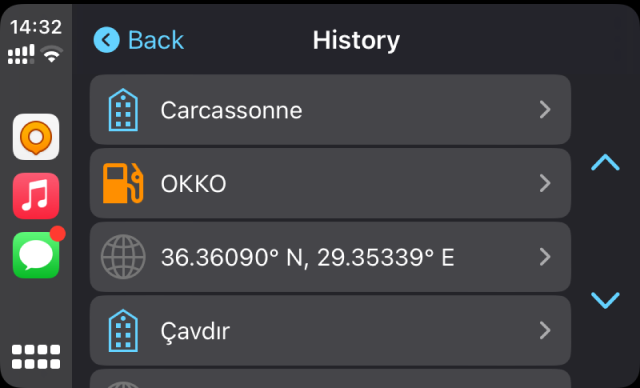
In the History category, you can select a destination from a list of endpoints.
- They are sorted by most recent use, starting with the newest ones.
- This can be convenient for quick access to frequently used routes.
- To learn how to use or delete a destination, read the Search History article.
POI Categories
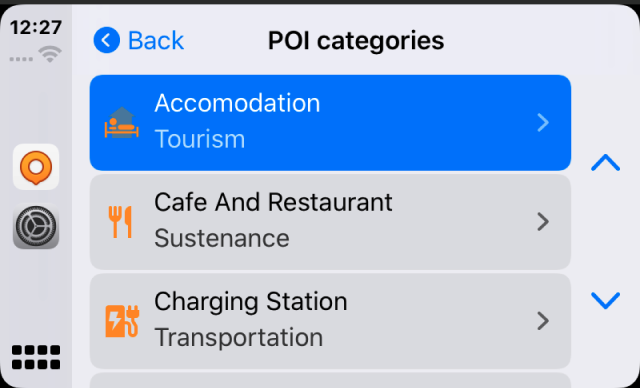 | 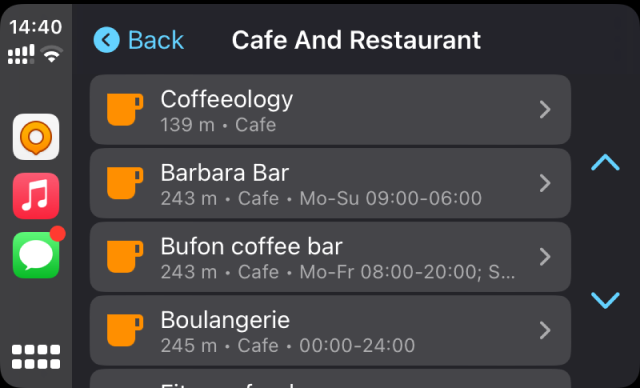 |
POIs (Points of Interest) are a type of points that identify places or objects on the map that are important or of interest to users. They are highlighted by special icons provided in the OsmAnd settings and sorted into groups.
To build a route to a POI in CarPlay, follow these steps:
- Select the needed POI from the list of available categories, or enter the name of the POI using Search.
- OsmAnd calculates the route and displays it on the CarPlay screen. Tap the Start button to start navigating to that location.
- Depending on your OsmAnd app settings and your vehicle, you may receive voice prompts to guide you to your destination.
- When you arrive at the location, the app will notify you that you have reached the POI.
Favorites
-3392a480600f545b7e33dd1ac7a2f98a.png)
Favorites is one of the features of OsmAnd that allows you to make a kind of notes on the map.
- While using CarPlay, you cannot add or modify Favorites, only use existing ones.
- The list of Favorites can be found in the OsmAnd app Menu → My Places → Favorites.
- If you want to use them for navigation, configure everything you need before connecting the device to your vehicle multimedia system.
Map Markers
-4a40b921596392a940088be04871a1e9.png)
- To define your final destination as a Map marker, you first need to create the required number of markers in the OsmAnd app on your device before connecting it to the vehicle multimedia system.
- Markers need to be available in the Menu → Map marker list.
- This is described in more detail in the Markers article.
Tracks
-c01fa86c93eee647b43428e9f46a8f72.png)
To build a route to a destination, you can select an existing track available in the OsmAnd app. The track can be downloaded in advance, used as recorded or created in Plan a route.
From the list of tracks in the Menu → My Places → Tracks, select the required one before connecting to the vehicle multimedia system, and the route will either build up to the start of the track or display the current direction along the track.
Tracks can also be selected directly on the vehicle screen in CarPlay. They are organized in folders you have created, and for easy and quick access to recently opened tracks, there is a special folder Last modified.
Search
-8d6bc571343ea375bc72c4f80d9eb0e2.png)
Going to Search gives you quick access to a list of recent destination history. Similarly with the Navigation menu, where all OsmAnd destination methods such as an address, POIs, or coordinates are collected.
You can use the Search tool to find the required place on the map for route planning from any available search category.
- Address. Start typing the address in the search field.
- POI and Custom POI. The list of nearby similar names will also display POIs or their categories.
- Coordinates search. Enter the coordinates to find the point on the map.
Folder Last Modified
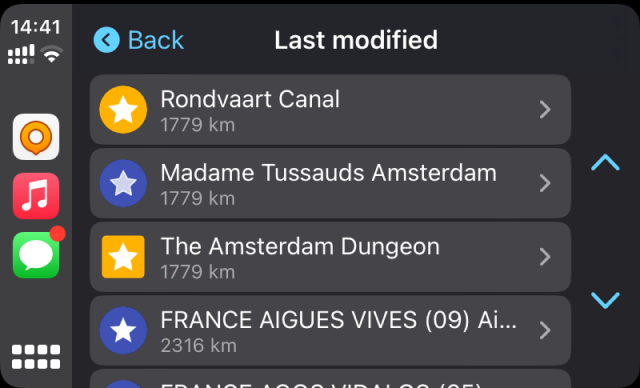
The Favorites and Tracks categories have a special Last Modified folder. Since the list in these categories can be very large as it contains all your existing favorites or tracks, this folder is necessary for easy and quick access to your most recent destinations.
Additional Features
In addition to the basic features of the OsmAnd app in CarPlay that provide convenient navigation in your vehicle, there are a number of additional features that enhance your experience and make navigation more personalized, comfortable, and efficient.
Voice Prompts
Voice guidance for CarPlay is one of OsmAnd's most useful navigation features, providing real-time guidance and allowing the driver to stay focused on the road. Voice prompts clearly indicate turns, directions and other navigation instructions, ensuring a safer and more comfortable use of the navigation system.
To configure voice prompts according to the selected profile, you have to do this before starting a route in the OsmAnd app on your device. To see recommended settings for CarPlay, go to the Voice prompts / Notifications article.
Announce Incoming Text Messages
You can change the notification settings for the OsmAnd app in the system settings of your device. Tap CarPlay, then select one of the following items:
- Announce New Messages
- Silence New Messages
- Remember Previous Setting
You can also enable or disable Announce messages directly in CarPlay. Read about how notification management is implemented on iOS and CarPlay.
Screen Alert Widget
-8e04b4cd6f9af2f3f890d6539644475b.png)
This information widget combines alert types such as Pedestrian crosswalks and Speed Limit.
- The types of alerts have different appearance, which depends on the Driving region and can be configured in Menu → Configure profile → Navigation settings → Screen alerts.
- In Car Play it is not possible to set the display of alerts, you need to configure the widget in the application before starting the navigation and connecting your device to the vehicle.
- For a detailed description of the alert types, see this article.
- To set up screen alerts for available profiles, see the article Navigation settings.
Speedometer

Speedometer widget is an integrated interface element that displays current speed using GPS data and speed limit from the OSM database and OsmAnd settings on the vehicle's multimedia system screen.
- The Speedometer widget is profile dependent, so if you change the settings for one profile, they will not be applied to another.
- There is no option to set the display of Speedometer directly in CarPlay. You need to configure it for selected navigation profile in the OsmAnd application before starting the navigation and connecting your device to the vehicle.
- For more information on how to add and configure the Speedometer widget to the display, please read the Informational widgets article.
Map Appearance (3D)

The OsmAnd app allows you to use the 3D map view on the CarPlay screen to display your route and navigation.
- The 3D / 2D button is displayed on the CarPlay screen.
- You can switch between 3D / 2D map modes by tapping this button.
Multifunction Dashboard

The OsmAnd app can be opened and used to navigate in CarPlay on the vehicle multimedia system screen simultaneously with music, message or other notification apps.
- Setting up the multifunction dashboard on a phone connected to CarPlay or on the screen in your vehicle system.
- Find Multi window button and switch it.
Volume Control Issue
Sometimes CarPlay doesn't connect, or you just can't hear anything even though it's connected. Other times, the OsmAnd app doesn't open properly in CarPlay. Possible solutions:
- In most cases, all signals remain at constant full volume, separate from the audio playback settings at the same time. To change the volume of the OsmAnd navigation prompts when using CarPlay, go to Setup → Voice → Voice volume on the vehicle multimedia system screen.
- Restart the device.
- Make sure CarPlay is enabled on your iPhone. To do this:
- Go to your phone's settings and then to General.
- Go to CarPlay in General Settings and select My Cars. Here you can customize your car by forgetting it or reconnecting to it.
- Make sure your Bluetooth is connected.
- Check the USB cable.
- Update your operating system regularly.
- Check that CarPlay is supported in your region.
- If you use a VPN on your iPhone, it may prevent CarPlay from working. Try disabling the VPN and see if this will help CarPlay to work.
Related Articles
Common Issues and Solutions
- Common questions about the connection screen:
- Why can’t I control the app from my phone when connected to CarPlay?
For safety reasons, the OsmAnd app screen on your phone is locked while connected to CarPlay. You can interact with the app only through the car display. - Can I disable the locked screen and use the app on my phone?
No, CarPlay enforces this restriction to prevent distractions while driving. - What should I do if my phone and car display seem disconnected?
Ensure your device is properly connected via USB or Bluetooth.
Restart your car’s infotainment system and the OsmAnd app if the connection is unstable.
- Why can’t I control the app from my phone when connected to CarPlay?
This article was last updated in January 2025